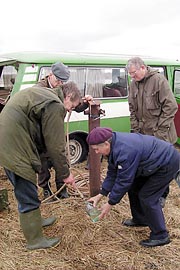
Ground water quality typically is determined by analyzing samples acquired from cased monitoring wells. Traditionally, three to five casing volumes of water are purged from each well prior to sample acquisition, typically at high pump rates or with a bailer. This is intended to remove stagnant casing water from the borehole, replacing it with water from the aquifer. Samples then are obtained in much the same manner, i.e. by bailing or high-speed pumping. This approach to purging and sampling may seem reasonable, but numerous problems can occur that affect both sample quality and data interpretation.
It was discovered, during investigations of potential contaminant transport by mobile colloidal particles, that traditional purging and sampling were disrupting the aquifer and sand pack materials. The disruption was caused by the stress of high water velocities and/or water surging in the wells due to sampling with bailers and high-speed submersible pumps. This left no conclusive way to determine whether collected particulates in the samples were naturally occurring or due to the disturbance caused by the sampling device/approach.
Such induced stresses can cause grain flow within the sand pack and/or exceed the cohesive forces of aquifer mineral cementation, resulting in excessive and artificial sample turbidity. This increased turbidity can radically alter analytical results for water samples, causing spurious increases in analyzed metal concentrations. This is particularly true for the major constituents of the aquifer mineral matrix, such as iron, aluminum, calcium, magnesium, manganese and silicon. Therefore, it has become standard practice for metals samples to be filtered to eliminate turbidity. This is the classical analytical definition of “dissolved” metals.
Unfortunately, colloidal particles often are smaller than the filters and can pass through the filter but cannot be considered “dissolved” for site transport modeling, risk assessment or geochemical understanding. Such particles may or may not be naturally mobile in the aquifer. In addition, particles larger than the filters can be mobile in subsurface systems and may carry adsorbed contaminant species. These will be filtered out. Therefore, estimates of the contaminants in an aquifer may be either too high or too low, depending on a complex interrelationship between geophysical and geochemical conditions. This degree of complexity has arisen without even considering that the mean particle exclusion size of the filter can change during the course of the filtration due to filter pore plugging and blockage as excluded particles accumulate on and in the filter.
The collection and analysis of both filtered and unfiltered samples sometimes is suggested, but this data cannot resolve either the dissolved or colloidal contaminant concentrations. There is no way to know which, if either of the samples, accurately represents anything following the artificial particle entrainment, whether filtered or not. When aquifer/sand pack disruption occurs, fresh, reactive mineral particle surfaces are exposed to the aqueous solution. This provides a potentially very large surface area of reactive adsorption sites to bind the dissolved contaminants of interest. When the samples are filtered to remove the particles, the bound contaminants also will be removed. It also is possible that the disruption can release contaminants that were previously bound to, or incorporated within, the aquifer mineral matrix and were previously immobile and of no concern to human health and the environment. This release would yield artificially high contaminant values.
These considerations make it important to develop sampling methods that do not disrupt the aquifer matrix or sand pack and eliminate the need for filtration. Once artificial sample turbidity has occurred, there is no filtration method or sample treatment that can restore confidence in the data quality.
ND
Report Abusive Comment